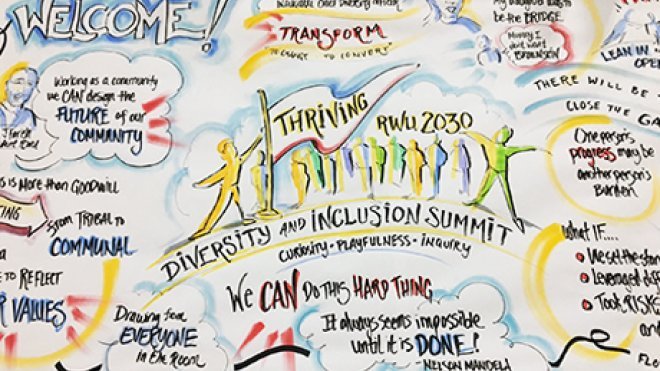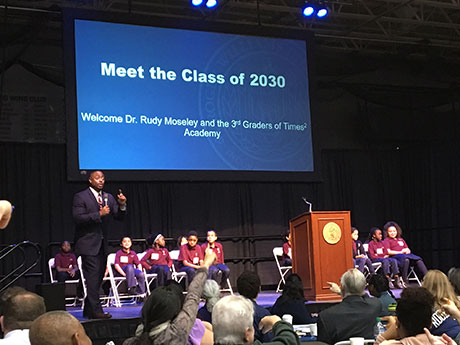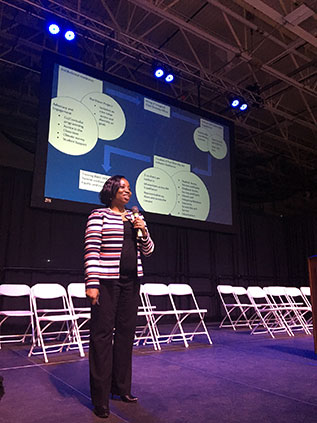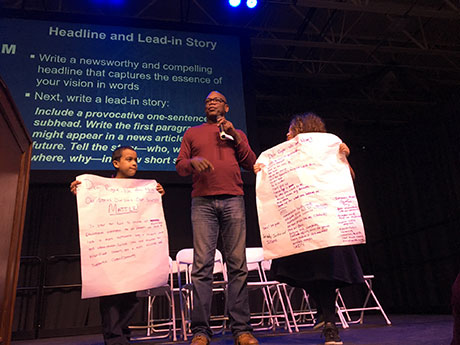To Change the World, We Have to First Dream It
More than 300 attend “Thriving RWU 2030: A Summit on Diversity and Inclusion”

BRISTOL, R.I. – More than 300 people – including Roger Williams University students, faculty, staff, and members of the greater community – turned out Tuesday for an intensive, inspiring daylong workshop to envision a more inclusive and equitable future at RWU.
At “Thriving RWU 2030: A Summit on Diversity and Inclusion,” the campus and greater community launched a long-term initiative to create a path forward for greater equity, inclusion and diversity at RWU.
“Today, we can have a nice day-long event that becomes a memory – or we can start a revolution where the co-conspirators include senior leaders, first-year college students, elementary school students, internal employees and community partners,” said Ame O. Lambert, who began working as RWU’s inaugural chief diversity officer in June. “I invite us to honor the spirit of our namesake Roger Williams by boldly standing out from the crowd in this area and doing the deep work that ensures we will have the impact we seek. Let’s go all in.”
President Donald J. Farish noted RWU’s goal is “to build the university the world needs now,” in part “by hiring faculty and staff, and recruiting students, who mirror the diversity of our region.” But the question isn’t just how to create greater diversity among students and faculty, he said, it also involves asking: “How do we create an environment where people who have not been a part of our community before can thrive?”
“We see all the time that this is a struggle in this country today that is hard won,” Farish said. “There are as many steps backward as there are forward. So the fact that so many of you said, ‘This is a conversation I’d like to personally be involved in’ gives me a sense of optimism that, working as a community, we can design the community of the future that we want to be a part of: a more inclusive, more diverse community and one that continues to reflect the values that we hold dear at this institution.”
Meeting the Class of 2030

To prepare the participants for visioning the future of RWU, a group of third-graders from Times2 STEM Academy, a Providence charter school, provided an emotional, motivational high point for the day, taking the stage and talking about their dreams as representatives of the Class of 2030.
The Times2 students have been studying the Rev. Martin Luther King Jr., who once told his mother, “One day I am going to turn this world upside down.” So Times2 Executive Director Rudolph A. Moseley Jr. asked them how they intend to turn the world upside down.
“I want to be the mayor,” third-grader J’mil Taylor replied, “to try to make the city a better place.”
Other students talked about wanting to be a nurse, a soldier or an emergency doctor.
Moseley asked the students to close their eyes and say: “I’m brilliant. I’m smart. I’m a world changer. I’m innovative. I have good ideas. And I’m going to change the world.”
Following that, the audience in unison told the students, “You can do it!”
Moseley noted that not many third-graders get to go to college for events such as Tuesday’s summit. “This is amazing. They will never forget this as long as they live,” he said. “We have to create more opportunities like this so students have a sense of belonging – that ‘I belong in a university setting,’ that ‘I belong in a professional environment.’ This is how you do it.”
“In order to change the world, we have to first dream it,” Moseley said. “You have to see it, you have to believe it, and then once we see the dream, then the how becomes plausible.”
Where We Are and Where We Should Be
Before diving into small group brainstorming sessions, a trio of RWU students provided context for the day’s discussions.

Diana Figueroa, a Latina student majoring in historic preservation at Roger Williams, said Latinx students now make up just 6.2 percent of the RWU students and 4.3 percent of its faculty and staff. “But by 2030, Latinx will be the primary growth engine in high school enrollment,” she said. “By 2030, we will be the second largest student population in the U.S. and will be 43 percent more than today’s enrollment numbers. Educational leaders must have a crucial focus on the diverse spectrum of Latinx students and their success throughout their preschool-to-college and career journey.”
Meg Silvestre dela Dingco, an Asian-American student majoring in international business, said Asian students make up less than 2 percent of RWU students and 4.3 percent of its faculty and staff. “Asian high school student levels will be a strong contributor to enrollment growth in our country between 2025 and 2030 and will be 27 percent greater than today’s numbers,” she said. “There will be more Southeast Asians, in addition to East Asian and South Asian students. Many of these students have different experiences and needs that are not adequately served by the model minority myth. Educational institutions will need to disaggregate the data and serve the unique needs of these populations.”
Tyler Porter, a black student majoring in architecture, said black students make up less than 3 percent of RWU students and 3.4 percent of its faculty and staff. “By 2030, there will actually be 6 percent fewer black high school graduates, which means that there is a need to ensure that more of us get to and through college,” she said. “However, this is not the full story. I am a Jamaican-American and immigration will shape America’s future, regardless of who is in office or what policies are in place. We are here and we will keep coming. The number of immigrants is projected to increase from current levels over 33.9 million to 38.5 million by 2035.”
Creating a Vision for the RWU Class of 2030
Later in the day, the crowd broke into smaller groups that delved into five areas: student access and success; employee access and success; campus climate and intergroup relations; education, scholarship and service; infrastructure (leadership, capacity, systems and organizational change).

The groups produced a range of ideas, including calls to align RWU’s reward system for faculty and staff with the values of diversity and inclusion; to build places for affinity groups, including a place for multi-faith worship; to build a student union; to increase supports for minoritized students; and to strengthen connections between the Providence and Bristol campuses.
“Let me remind us of something we know: We can do hard things,” Lambert said. “Regardless of what the obstacles are or what our experiences have been so far, we can do this hard thing. So let’s get to hoping and working, and let’s amaze ourselves and the world. Because as Nelson Mandela so powerfully said, ‘It always seems impossible – until it’s done.’ ”
Lambert said task forces will synthesize the output from the five discussion areas, and a strategic plan for diversity, equity and inclusion will be presented to the RWU Board of Trustees in May.
But this isn’t the end of the discussion – it’s just the beginning of a revolution in higher education, where faculty, staff, students and community members will share in creating a more equitable, diverse and thriving institution that is committed to strengthening society.